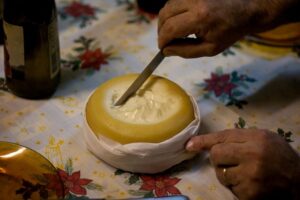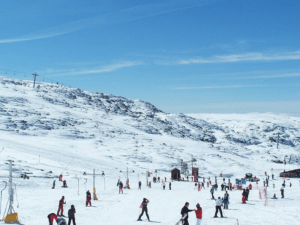
What to do in the Serra da Estrela area – Fall & Winter
The Serra da Estrela – the “mountain of the stars” – is the highest mountain range of mainland Portugal, two hours away from the vibrant city of Porto.
As the largest conservation area in the country, the Serra da Estrela is well known for its wild and raw nature. This extends to wool making, artisanal products, the shepherding tradition, the abundance of wild rivers and vast green pastures.
While summers are hot, averaging from mid-30s (centigrade) with a few days in the 40s, winters can be rough by Portuguese standards. Snow is common, and when combined with fog, it creates a mysterious vibe specific to the area.

Map of the Estrela GeoPark, Serra da Estrela
Hiking & enjoying nature
The Serra da Estrela mountains offer plenty of hiking options of all levels for nature lovers.
The app All Trails has 26 hiking trails available, from short ones (2km) to long ones (500 km!) depending on how much time you have on your hands and the level of difficulty you are looking for.
Villages in the region tend to have Tourism Information Centers with hiking and other information, often with myriad Grand Route (GR) hiking maps. Some even have user-friendly websites dedicated to this information – such as Manteigas – but that is the exception rather than the norm.
As an alternative to walking, there are opportunities to do horse-riding and mountain biking, including a bike trail around some of the “Aldeias Historicas” (historical villages). An ongoing project also aims to convert already existing paths, traditionally used by shepherds, to cycle paths.
Beyond that, you can discover the Zezere glacier Valley with its space, silence, and breathtaking views, or Faia Brava known for birdwatching.
Medieval Villages
Starting in September until the end of November, twelve fairs occur in twelve charming medieval towns. On the program: cultural events, talks, workshops, food stalls, and guided tours of the ancient castles. In short, the winter equivalent to summer medieval fairs!
These “Aldeias Historicas” (historical villages) include: Almeida, Belmonte, Castelo Mendo, Castelo Novo, Castelo Rodrigo, Idanha-A-Velha, Linhares da Beira, Marialva, Monsanto, Piodao, Sortelha, Trancoso.
All these villages played essential roles throughout history, whether related to trading or defending the territory from Spain. With time, far from the ocean and the glorious time of colonial “discoveries”, they progressively lost their importance. Yet they remain a representation of Portugal’s rich history, home of successive invasions, from Lusitanian tribes to the Visigoths, the Romans, the Moorish, and more.
Other notable villages & fairs
In Portugal, there are always popular fairs going on to celebrate particular moments of the year.
Alcaide: The “Miscaros Festival” celebrates mushrooms with activities ranging from mushroom hunting with experts to talks and artisanal offerings. If you are curious about or love mushrooms and mushroom hunting, there is a lot more to dive into…
Celorico da Beira: In October, there is the “Festival do Borrego“, which celebrates local gastronomy and the Borrego (lamb) meat, whose quality is protected by the label DOP.
Seia: On a rainy day, you can visit the Museu do Pão (Bread Museum) in Seia where you will learn how the Portuguese make this staple food.
Gouveia: Also around November, there are several “Festa da Castanha” happening all over Portugal, celebrating the chestnut season!

Seasonal goods – chestnuts & khaki fruit. Photo Credit: Alexia Dreau
Cheese tasting
Who says shepherding tradition, says cheese making!
The prime Serra da Estrela cheese is a young, gooey, and buttery cheese made from the Bordaleira sheep milk (link in Portuguese). Protected by the label DOP (which literally translates to “Protected Designation of Origin”), it guarantees that the production is local and handmade.
The way locals eat this cheese is that they open the top with a knife and scoop it directly into their mouth. Bread is optional.

Serra da Estrela cheese. Photo credit: Phill MV
The other cheese made locally is the Requijão. It’s a fresh cheese, similar to the Italian Ricotta, often served with “doce de abóbora” (pumpkin jam).

Requijão. Photo Credit: Hipersyl
Every year in February, the Feira do Queijo (Cheese fair) is an opportunity to try different local cheeses. If you want to know how they’re made, head to the Museu do Queijo (Cheese Museum) in Covilhã.
Learn about the wool making tradition
As the shepherding tradition is slowly disappearing as the new generation focuses on urban opportunities and office jobs, there is an effort to safeguard ancient knowledge. The Wool Museum in Covilhã showcases the machines and techniques used to make wool the way they used to since the 12th century.
You can also head to the Museu de Tecelagem, the Weaving Museum, in Meios (a 5 min drive from Casa Beatrix!). It’s small, with beautiful old weaving machines. There, you will learn about a traditional blanket used to fend off wolves, and they have a small shop with wool products sourced from the region and sold at cost as the Museum is supported by the Municipality of Guarda.
Last but not least, in Manteigas you can (re)discover burel, a Portuguese way of processing wool to make it waterproof and traditionally worn by shepherds. While the production is artisanal, a few designers invented new patterns to revive the tradition. The Burel Factory and Ecolã in Manteigas are open for visits, and boast designs used to decorate the new Google offices in Lisbon!
Dive into the local gastronomy
What better than to support local producers? The Serra da Estrela is known for a myriad of products:
- ● Mel das montanhas: honey from the mountains is dense with a deep taste
● Ginjinha: a sweet liquor made with a type of cherry
● Pastel de Feijoca de Manteigas: similar to the pastel de nata, but this one is made from a local bean
● Feijoca: a type of bean produced in the Serra da Estrela
● Enchidos: smoked sausages
● Sardinhas doces de Trancoso: sweets made with almonds, flour, sugar, and eggs and often shaped like sardines

Enchidos portugueses. Photo Credit: Adrião
Winter sports e.g., skiing & the highest point in Portugal
There is one ski station in Portugal! Nothing comparable to Switzerland, but it offers a dozen ski slopes, and is open from November to April.
At the Serra’s highest point, you’ll find Torre (“tower” in Portuguese) erected at 1993m above sea level. It offers a splendid panorama, and plenty of space to take long walks year-round.

Photo Credit: Wikimedia Commons (https://commons.wikimedia.org/wiki/File:Serra_da_Estrela_II_Portugal.jpg)
Festa das Luzes, or Hanukkah
Hanukkah… in Portugal? Yes, you read right. Historically, Belmonte – host of “The Celebration of Lights” – has close ties with the Jewish community, and is a place of pilgrimage for Jews from all around the world to honour the community who resisted religious intolerance in the 16th century.
If you’re curious to learn about the history of these Jews and how they invented a type of sausage – called “alheira” – made without pork to avoid persecution, head to the Judaism Museum and the Synagogue.
The above is but a selection of activities available in the region (we’re keeping basket weaving and motorbike rides for another time). The bottom line is that although Portugal is renowned for its summer days and holiday options, the Serra da Estrela is a rich region worth discovering year-round.
Any fall or winter activity you want to know more about, or that is missing? Let us know and we’ll do a deep dive!
[Featured image photo credit Gerd Eichmann]



